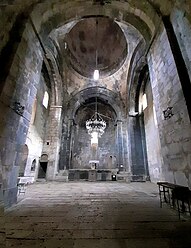Ashot III of Armenia
| Ashot III Bagratuni | |
|---|---|
Armenian Apostolic |
Ashot III (
Reign
During the first year of his reign Ashot launched a military assault to free the city of
In 961 Ani was proclaimed the capital of the kingdom, and Ashot set himself to enriching and expanding the city. Ashot constructed a wall enclosing Ani and that would later take its name after him, and sponsored the building of monasteries, hospitals, schools, and almshouses. His consort, Queen Khosrovanuysh, meanwhile sponsored the construction of the churches in Sanahin and Haghpat.[4][5]
In the war between the
Scholars have suggested that he was buried either in Ani or at the nearby Horomos monastic complex.[1]
Sub-kingdoms
A new phenomenon that began under Ashot III's reign and continued under his successors was the establishment of sub-kingdoms throughout Bagratuni Armenia. Ashot III had sent his brother Mushegh I to rule in Kars (Vanand) and had allowed him to use the title of king. The administrative district of Dzoraget near Lake Sevan was given to Ashot's son Gurgen, the progenitor of the Kyurikid line, in 966, who would later assume the title of king. The proliferation of so many kingdoms worked to the benefit of Armenia so long as the king in Ani remained strong and maintained his hegemony over other kings. Otherwise, the kings, as well their respective bishops who would claim the position of catholicos and formulate their own doctrines, would begin to test the limits of their autonomy.[8]
References
- ^ a b Manuk-Khaloyan, Armen, "In the Cemetery of their Ancestors: The Royal Burial Tombs of the Bagratuni Kings of Greater Armenia (890-1073/79)," Revue des Études Arméniennes 35 (2013), pp. 147-48, 164-65, 171-72.
- ^ Garsoïan, Nina G. (1997), "The Independent Kingdoms of Medieval Armenia" in The Armenian People from Ancient to Modern Times, Volume I, The Dynastic Periods: From Antiquity to the Fourteenth Century, ed. Richard G. Hovannisian. New York: St. Martin's Press, pp. 164ff.
- ^ Aram Ter-Ghevondyan (1976), The Arab Emirates in Bagratid Armenia, trans. Nina G. Garsoïan. Lisbon: Calouste Gulbenkian Foundation, pp. 95–96.
- ^ (in Armenian) Arakelyan, Babken N. (1976), "Բագրատունյաց թագավորության բարգավաճումը," [The Flourishing of the Bagratuni Kingdom] in Հայ ժողովրդի պատմություն [History of the Armenian People], eds. Tsatur Aghayan et al. Yerevan: Armenian Academy of Sciences, vol. 3, pp. 52–57.
- ISBN 978-0-19-093588-7.
- ^ Treadgold, Warren (1997). A History of Byzantine State and Society. Stanford: Stanford University Press. pp. 511.
- ^ Sullivan, Robert G. (2020). Art and Violence in the Middle Ages and the Renaissance. Cambridge Scholars Publishing. p. 88.
- ^ Garsoïan, "The Independent Kingdoms of Medieval Armenia," p. 166.


